AUTUMN PEST REVIEW: Although the season is beginning to wind-down, there are still a number of insect & mite pests that require scouting during the fall weeks. The pests discussed in this blog include soft scale nymphs, boxwood leafminers, white pine aphids, spruce spider mites, southern red spider mites, hemlock rust mites, eastern spruce gall adelgids & hemlock woolly adelgids. The use of low %-rates of horticultural oils this fall can be especially valuable against controlling many of these pests.
SOFT SCALE NYMPH MIGRATIONS: Most soft scale species (exceptions include magnolia, tuliptree, and globose) have 1st instar nymphs that spend July and August feeding along veins on the undersides of leaves of their deciduous host (the use of a hand lens may be needed). During the weeks of late summer and early fall, these nymphs migrate off the leaves onto woody stem tissue and molt into the overwintering 2nd instar stage. The size of the nymphs increases 3-times after molting and their presence is usually observable even without magnification (they can be as large as lenticels). Typically, overwintering soft-scale nymphs have a dark coloration, to help absorb sunlight and maintain body warmth.
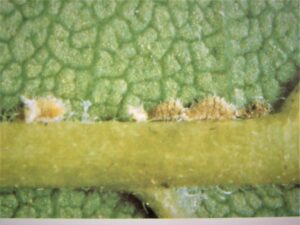
European elm 1st-instar nymphs settled along the main vein underneath elm leaf. During the early weeks of fall they migrate from leaves onto the bark to overwinter. (Photo Credit: Cornell University)
In contrast to armored scales, the various species of most soft scales are relatively easy to control during the fall (i.e., a notable exception is the Indian wax scale). Unlike armored scales, soft scales do not have a protective, external waxy cover. Soft-scale species are highly exposed and more vulnerable to dormant oil applications (dormant oil efficacy with a single spray against armored scales is usually not satisfactory). Treatment windows can include a fall oil spray after leaf drop (some labels advise caution with fall dormant oils) or an early spring oil spray before bud break. With larger trees, complete coverage may be difficult. The use of soil injection or drench of imidacloprid (Merit) or the other, newer neonicotinoids now available can provide excellent controls against soft scales. The key factor to always consider when using soil treatments is adequate soil moisture.
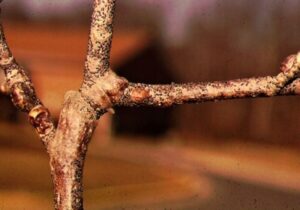
2nd-instar soft scale magnolia scale nymphs are obvious on woody stems. This soft scale actually never feeds on leaves, & all life stages are found on bark. (Photo Credit: Steven K. Rettke, Rutgers Coop. Ext.)
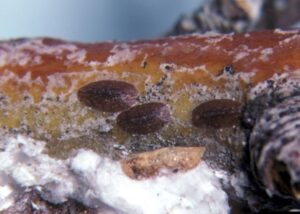
Cottony maple scale 2nd-instar nymphs overwintering on bark stems. The large, dark colored nymphs can be seen without magnification. (Photo Credit: Univ. of California)
Boxwood Leafminer (Monarthropalpus flavus):
This particular host-specific pest is a good example of why it can still be important to monitor plants during the off-season. Although the single-generation leaf miner larvae have been in boxwoods leaves since May, their presence in new foliage is often not readily apparent until the early fall. Most of the activity and feeding damage by the fly larvae are done during the fall and winter. Blister-like blotch mines are now just becoming noticeable on current season-infested leaves. While most insect pests are winding down for the year, the boxwood leaf miner is just heating up.

Although the boxwood fly maggots have been inside the leaves since May, the feeding symptoms are not easily seen until the early weeks fall. Probably more than half a dozen larvae are within this leaf. (Photo Credit: Steven K. Rettke, Rutgers Coop. Ext.)
When symptoms suggest their presence, “break the back” of the leaf and peel away the lower epidermis to detect the still clear and thin larvae (usually several are found in each leaf). As feeding continues through the fall months, the larvae develop into larger, yellow-colored maggots. After a mid-winter resting stage, the larvae begin feeding again in late winter. With heavy infestations, defoliation can occur in the spring.
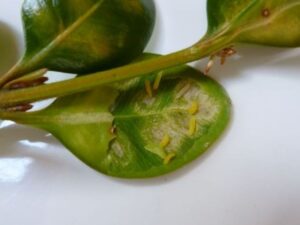
Exposed yellow colored larvae of boxwood leafminers. These maggots will continue to feed during cold weather. (Photo Credit: Steven K. Rettke, Rutgers Coop. Ext.)
The various neonicotinoid class root systemics should provide outstanding, long-lasting results against this pest. If good root uptake of the material is achieved, success is usually assured. Within a week, sufficiently lethal insecticide levels should be translocated up into the boxwood foliage if healthy roots and adequate soil moisture are present.
White Pine Aphids / Eggs: (Cinara strobi)
Cooler temperatures and rain can lead to a population increase with certain aphid species such as white pine aphids. A large aphid species (nearly ¼ inch), they are dark-bodied with a distinctive central white stripe and white spots on each side of the abdomen. White pine aphids do not feed on pine needles, but instead will be found on stems feeding in the phloem tissue. As sapsuckers, they will exude copious amounts of honeydew that usually attract numerous wasps, hornets, bees, and ants. These stinging, biting insects use the honeydew as a source of food. With high infestations, the needles will typically be covered with the black sooty mold that grows on the honeydew.
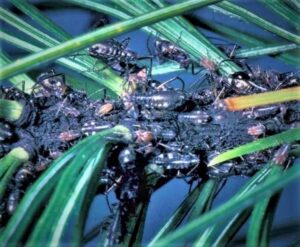
The white pine aphid species is large & reach nearly 1/4-inch in size. The dark body & distinctive central white strip with white spots on each sides of the body can be diagnostic. Prolific honeydew with black sooty mold is often common. (Photo Credit: Unknown)
Keep in mind that many insect predators and parasitoids remain active into the fall and effectively suppress aphids. For example, syrphid flies (also known as hover flies) prefer cooler temperatures and continue activity after lady beetles and lacewings have become inactive. Horticultural oil can provide controls against both feeding aphids and overwintering black eggs. Although they have several generations during the season, they often become most prominent on eastern white pines during the weeks of October when the black, jellybean-like overwintering eggs are laid on needles. The eggs are laid like a string of beads in a straight line along the length of individual needles. Where laid, select needles can contain a dozen or more eggs. When closely observed later in the fall, the black eggs on highly infested trees will become very apparent on many needles.
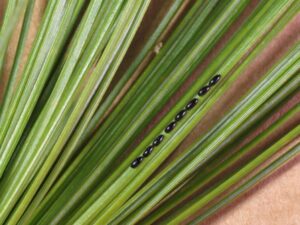
White pine aphids will lay shiny black eggs like a string of beads along the length of a pine needle during the fall. (Photo Credit: North Carolina Coop. Ext.)
HEMLOCK SYMPTOMS = Spruce Spider Mites (Oligonychus ununguis) vs. Hemlock Rust Mites (Nalepella tsugifoliae):
Two different species of mites that commonly attack hemlock trees, each have distinctive symptoms. Spruce spider mites produce a whitish, chlorotic stippling pattern at the base of individual hemlock needles (up to a ¼ of the needle may show this stippling at the base). Characteristically this whitish discoloration is very uniform on many of the needles of infested branches. Some of your clients might even mistake these symptoms for hemlock woolly adelgid pests. On the contrary, hemlock rust mite feeding symptoms produce a dull and olive appearance to the needles. Also, instead of concentrating their stippling at the base of the needle, this rust mite feeding pattern is evenly spread. Hemlock rust mites are only 1/3 the size of spruce spider mites and as a result, their smaller mouthparts produce much finer stippling on the needles.
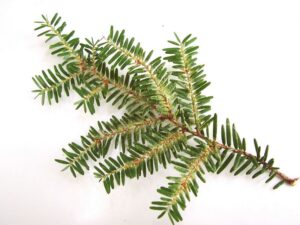
Classic spruce spider mite feeding symptoms on Canadian hemlock. Mites feed primarily at lower needle locations near twig stems. (Photo Credit: Steven K. Rettke, Rutgers Coop. Ext.)

Rust mites cause the needles to turn a light yellowish green color. They can feed on both sides of the entire needles. Numerous cast skins can give the needles a dusty appearance. (Photo Credit: Steven K. Rettke, Rutgers Coop. Ext.)
Both species are cool-season mites and are active during the spring and fall months. Although both can be active on the same tree at the same time, the hemlock rust mite (an eriophyid mite) is more active at lower temperatures than the spruce spider mite. The hemlock rust mite has even been called a cold-season mite. Spruce spider mites often become active by mid-September, if not earlier, and can continue feeding and egg-laying through November and into December. Hemlock rust mites may not resume activity until October and will also continue activity into the late weeks of fall. Both mites overwinter as eggs on twig bark and therefore can be controlled with horticultural oils.
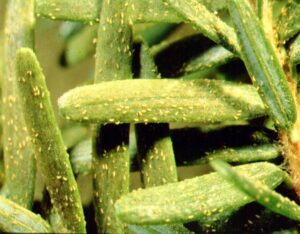
The light yellow, spindle shaped hemlock rust mites can build-up into hugh populations. These mites move slowly & may require 20x magnification to to view. (Photo Credit: Ohio State Coop. Ext.)
Southern Red Mites (Oligonychus ilicis):
A spider mite species that will feed on broadleaf evergreens during both the spring & fall months has commenced activity and may continue through at least November within most areas of NJ. This cool season spider mite has red-colored eggs that are easily visible with a 10x hand lens. They have several generations during the spring & fall seasons. The spruce spider mite that feeds on needle conifers often receives the most attention during the spring & fall months, but the southern red mite can cause a great deal of aesthetic damage to broadleaf evergreens such as Japanese holly. They also commonly feed on Azalea, Rhododendrons, mountain laurel, yew, camellia, & viburnum.
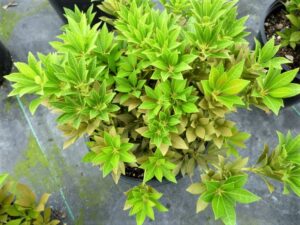
By the late spring, the newer growth by this Pieris japonica has nearly covered the symptoms from southern red spider mites that occurred during the previous fall & early spring. (Photo Credit: Steven K. Rettke, Rutgers Coop. Ext.)
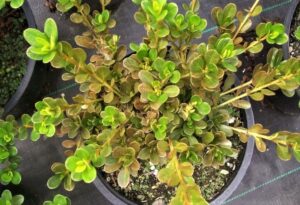
The stippling symptoms by southern red spider mites are clearly visible on the azalea foliage. Newer growth has not yet covered-up the damaged leaves. (Photo Credit: Steven K. Rettke, Rutgers Coop. Ext.)
Adults are purple-red and are about 1/50 of an inch (0.5 mm) in size. Look for white stippling damage on the foliage. They feed & damage cells on both upper & lower leaf surfaces. Lower leaf surfaces often appear dusty because of the numerous whitish eggshells and shed skins. The red eggs hatch in the spring & fall seasons but are readily visible on leaf undersides during the dormant winter & summer periods.
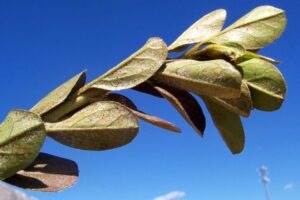
Dark-red eggs & active southern red spider mites are seen here under azalea leaves. Also, white colored egg shells & mite cast skins are apparent. (Photo Credit: Steven K. Rettke, Rutgers Coop. Ext.)
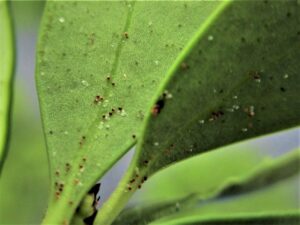
Close-up of the red colored eggs of southern red spider mites underneath leaves of Pieris japonica. (Photo Credit: Steven K. Rettke, Rutgers Coop. Ext.)
If more than 10-15 mites can be knocked onto a beating tray/white paper, then control with horticultural oil or insecticidal soap. If more than 10% damage is evident, then use Avid, Hexygon, Florimite, or one of the labeled pyrethroids. Especially when using pyrethroids, return monitoring visits are important to evaluate effectiveness since eggs are not killed. Typically, additional sprays will be required with high infestations. Eggs will continue to hatch until December, then overwinter until they resume activity again in the spring.
ADELGIDS: The Eastern Spruce Gall, Cooley Spruce Gall, and Hemlock Wooly Adelgids all overwinter as immature females and are vulnerable to control treatments during the late months of the year. The product of choice when applying sprays is the use of horticultural oils or soaps when good coverage can be achieved (soaps can be especially effective against adelgids).
Remember to target sprays onto only the most recent growth or terminal twigs and buds. Treatments onto the older, inner needles and branches will miss the target. Significant populations of HWA on taller trees will benefit most from imidacloprid soil treatments.
Eastern Spruce Gall Adelgid (Adelges abietis):
This spruce gall species forms at the base of the current year’s growth. Cooley spruce galls, on the other hand, form at the terminal tips of new twigs. Typically, the Eastern spruce gall adelgid (ESGA) is found on Norway spruce, while the Cooley spruce gall adelgid is found on Colorado blue spruce. Often the ESGA has the potential to be more damaging to the aesthetic appearance of highly infested trees.
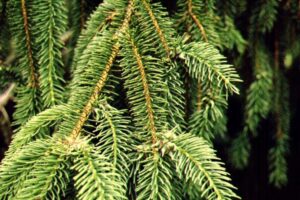
Once the galls of the eastern spruce gall adelgids have formed at the base of twigs, there are limited chemical controls available. (Photo Credit: Steven K. Rettke, Rutgers Coop. Ext.)
Although they have only one generation per year, there are two control window opportunities when attempting to manage the ESGA. The first control window is during the early spring (late March to early April). The target is the overwintering stem mother before eggs are laid. The second window is early fall (mid-September thru October). During both windows, the target to inspect for is small, white webbing located at the base of lateral or terminal buds (10X hand-lens might be useful). These are the protective overwintering sites of the adelgid stem mother.
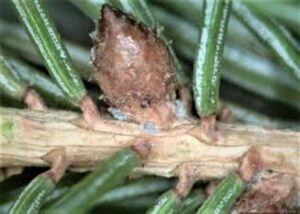
The overwintering immature nymphs of the eastern spruce gall adelgids at the base of bud. Control them with horticultural oils or insecticidal soaps during the fall or spring before the lateral buds swell & the stems elongate. (Photo Credit: Cornell Coop. Ext.)
Not even systemic insecticides will affect the nymphs within the galls (conducting tissues are limited within the galls). Good results are achieved by targeting the overwintering females (before eggs are laid) or recently hatched nymphs with oil or soap. Horticultural oil or insecticidal soap will both provide excellent controls with adequate coverage (if it isn’t drippin’ – then you’re slippin’). If the conifers are under drought conditions, it would be wise to show precaution when using either soaps or oils now. When conditions permit this fall, insecticidal soaps will provide outstanding efficacy against adelgids.
Hemlock Woolly Adelgids: (Adelges tsugae):
Fall is an excellent time to control this adelgid pest if no controls have been applied to date. The nymph is exposed on the underside of new growth. The HWA covers itself with waxy, white secretions from late October into early November. Ideally, to achieve the best efficacy, it would be better to apply spray treatments before the adelgids produce the protective white webbing. Fall treatments of insecticidal soap, horticultural oil, or Merit are highly effective.
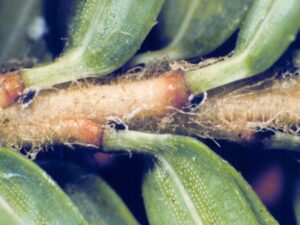
Hemlock woolly adelgids will settle, feed & mature at the petioles of individual hemlock needles. Applying control sprays before they become surrounded by white waxy threads will enhance efficacy. (Photo Credit: John Davidson, UMD Coop. Ext.)
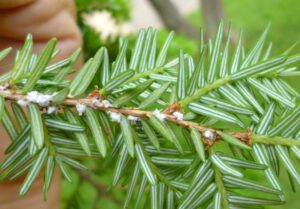
Hemlock woolly adelgids will surround themselves with white waxy threads late during the fall. This will provide winter protection & also a place to lay eggs during late winter. (Photo Credit: Steven K. Rettke, Rutgers Coop. Ext.)
Information from the US Forest Service indicates that hemlocks that have experienced over 50% needle loss from the adelgid will not recover to satisfactory levels in subsequent years (even if treated). Therefore, treatments must be made when the needle loss is below 50% if hemlocks are to maintain ornamental value.
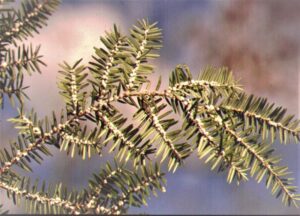
Canadian hemlock with a heavy infestation of hemlock woolly adelgids. Over the years, the infested hemlocks will typically gradually die-back starting at the base of the tree & working up. (Photo Credit: Steven K. Rettke, Rutgers Coop. Ext.)

